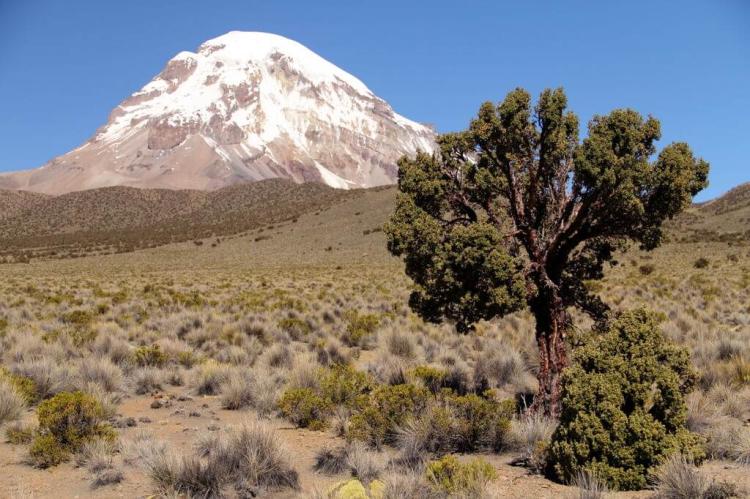The Cordillera Central Páramo: A High-Altitude Oasis of Andean Biodiversity
High in the Andes of Bolivia and Peru lies a breathtaking expanse of rugged terrain and pristine wilderness—the Cordillera Central páramo. This remarkable landscape, nestled amidst towering peaks and alpine valleys, captivates the imagination with its stark beauty and extraordinary biodiversity.
The Cordillera Central Páramo: A High-Altitude Oasis of Andean Biodiversity
Nestled within the heart of the Andes, straddling the borders of Bolivia and Peru, lies the Cordillera Central páramo ecoregion, a high-altitude expanse that captivates with its rugged beauty and ecological significance. This unique ecosystem, situated between the treeline and the permanent snowline, stands as a living testament to the resilience of nature in the face of extreme conditions.
Geographical Setting
The Cordillera Central páramo ecoregion stretches across the central Andean cordillera, encompassing portions of southwestern Bolivia and southeastern Peru. Characterized by glaciated peaks and valleys, this region rises majestically to elevations ranging from 3,500 to 5,200 meters (11,500 to 17,000 feet) above sea level.
A Harsh yet Resilient Environment
The páramo ecoregion is a harsh landscape with gusting winds, intense solar radiation, and extreme temperature fluctuations are the norm. Despite these unforgiving conditions, a remarkable flora and fauna have adapted to thrive in this high-altitude realm.
Climate and Topography
The Cordillera Central páramo's climate is characterized by low temperatures, with an average annual temperature ranging from 3°C to 8°C (37°F to 46°F). Precipitation patterns are highly variable, with some areas receiving significant rainfall while others remain relatively dry. The rugged topography, marked by steep slopes, deep valleys, and glaciated peaks, further contributes to the region's unique microclimates.
A Biodiversity Hotspot
The Cordillera Central páramo ecoregion is a biodiversity hotspot, harboring a rich tapestry of plant and animal life that has adapted to the extreme conditions of this high-altitude environment.
Flora
The páramo vegetation is dominated by a unique assemblage of grasses, cushion plants, and dwarf shrubs, collectively known as "páramo flora." To withstand harsh conditions, these resilient species have developed remarkable adaptations, such as dense hairy coverings, waxy coatings, and compact growth forms. Examples include the iconic Puya raimondii, a towering bromeliad, and the striking Espeletia plants with distinctive woolly leaves.
Fauna
The animal life of the Cordillera Central páramo is no less remarkable. The region serves as a crucial habitat for various endangered species, including the iconic vicuña, a llama relative, and the majestic Andean condor, the largest flying bird in the world. Other notable inhabitants include the Andean fox, the viscacha (a type of chinchilla), and a diverse array of high-altitude bird species, such as the rufous-bellied seedsnipe and the diademed sandpiper-plover.
Conservation Challenges and Efforts
Despite its remote location and harsh environment, the Cordillera Central páramo ecoregion faces numerous threats, including overgrazing, mining activities, and climate change impacts. Local communities, non-governmental organizations, and government agencies have undertaken conservation efforts to address these challenges.
Community-Based Conservation
Initiatives have been launched to engage local communities in sustainable practices, such as rotational grazing and ecotourism ventures. These efforts aim to balance traditional livelihoods and environmental conservation, fostering a sense of ownership and stewardship among the region's inhabitants.
Protected Areas
Recognizing the importance of preserving this unique ecosystem, several protected areas have been established within the Cordillera Central páramo ecoregion. These include the Sajama National Park in Bolivia and the Huascarán National Park in Peru, which are designated as UNESCO World Heritage Sites.
Climate Change Adaptation
Researchers and conservationists are working to develop adaptation strategies as the páramo ecosystem faces the looming threat of climate change, researchers and conservationists are working to develop adaptation strategies. These efforts include monitoring changes in species distributions, implementing habitat restoration projects, and exploring alternative livelihood options for local communities.
Conclusion
The Cordillera Central páramo ecoregion stands as a testament to life's resilience in the face of adversity. This high-altitude oasis, nestled within the rugged Andean landscapes of Bolivia and Peru, harbors a unique and fragile biodiversity that demands our attention and protection. Through collaborative efforts involving local communities, governments, and conservation organizations, this remarkable ecosystem can be preserved for generations to come, safeguarding its ecological wonders and the cultural heritage intertwined with its existence.
